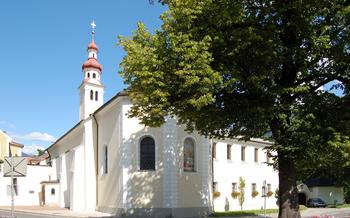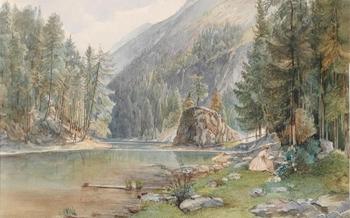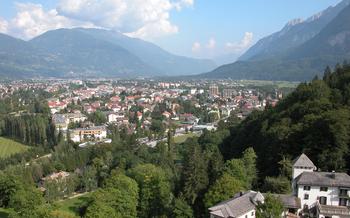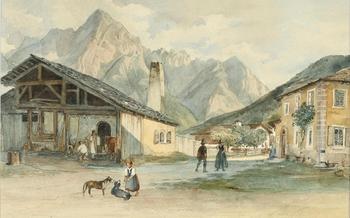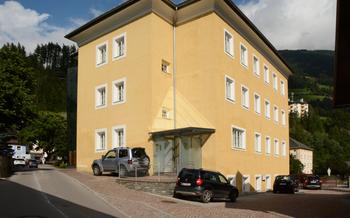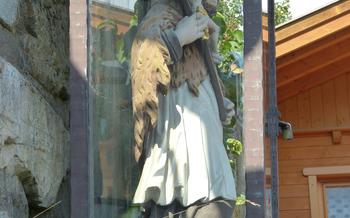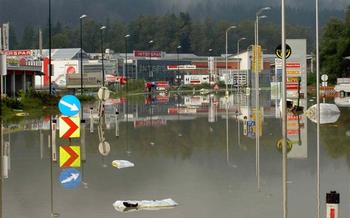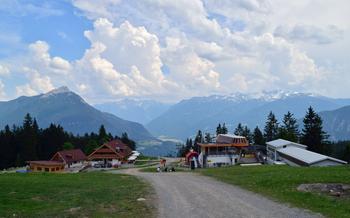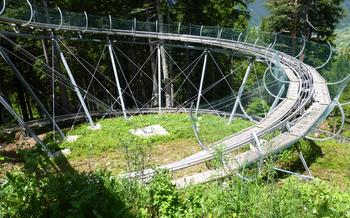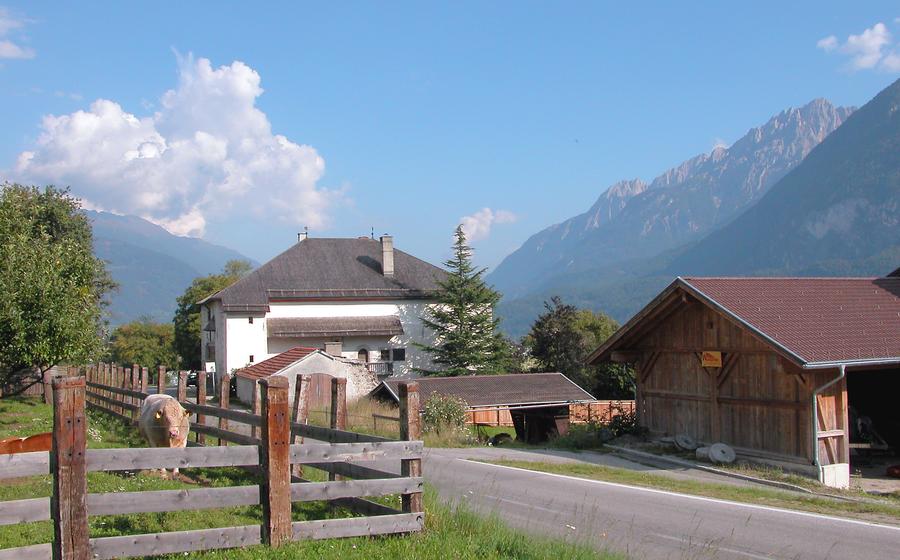
The Roman Milestone
- The Roman Milestone in Lienz, Austria: A Journey Through History
- Location:
- Historical Context
- Cultural Importance
- Tourism and Accessibility
- Interactive Elements
- Educational Value
- Photography and Social Media
- Local Cuisine and Dining
- Souvenirs and Shopping
- Nearby Attractions
- Events and Festivals
- Accommodation and Lodging:
- Insider Tip: Explore the Ancient Roman Ruins Underneath Lienz
The Roman Milestone in Lienz, Austria: A Journey Through History
Historical Significance:
Lienz, a picturesque town nestled in the heart of the Austrian Alps, boasts a rich history dating back to ancient Roman times. One of the most intriguing relics of this era is the Roman Milestone, a silent witness to the empire's enduring legacy. This ancient stone marker, standing proudly at the confluence of two significant Roman roads, Via Claudia Augusta and Via Iulia Augusta, serves as a tangible link to the past, offering a glimpse into the grandeur and engineering prowess of the Roman Empire.
The Roman Milestone in Lienz is not just an artifact; it's a symbol of the town's deep-rooted heritage. It represents a time when Lienz was a bustling hub along the Roman trade routes, connecting the empire's far-flung provinces. The milestone served as a guidepost for weary travelers, marking the distance to important destinations and ensuring the smooth flow of commerce and communication across the vast Roman network.
Beyond its practical function, the Roman Milestone holds cultural and historical significance. It embodies the Roman Empire's meticulous record-keeping and administrative systems, which were essential for maintaining control over their vast territories. The inscriptions on the milestone, though weathered by time, provide valuable insights into the Roman Empire's infrastructure, governance, and the lives of its people.
As you stand before this ancient relic, let your imagination transport you back to a time when Roman legions marched along these very roads, when merchants and pilgrims journeyed far and wide, and when the Roman Empire's influence shaped the course of European history. The Roman Milestone in Lienz is an invitation to explore the depths of history, to connect with the past, and to appreciate the enduring legacy of the Roman Empire.
Location:
The Roman Milestone in Lienz, Austria, stands as a testament to the ancient Roman Empire's presence in the region. Situated in the heart of the city, the milestone can be found at the following address:
Römerplatz 1, 9900 Lienz, Austria
GPS Coordinates:
Latitude: 4837380
Longitude: 760574
In ancient times, the Roman Milestone marked the intersection of two important Roman roads: the Via Claudia Augusta, which connected Italy with the Danube River, and the Via Iulia Augusta, which ran from Aquileia to Salzburg. Today, the milestone serves as a reminder of the vibrant trade and travel that once took place along these ancient routes.
To reach the Roman Milestone, visitors can conveniently use public transportation or private vehicles. The nearest bus stop, "Römerplatz," is just a short walk away, providing easy access for those without a car. For those driving, there are several parking options available in the vicinity, making it convenient to explore the milestone and the surrounding area. A detailed map or directions can be found on the official website of the Lienz Tourism Board, ensuring that visitors can easily find their way to this historical landmark.
Historical Context
The Roman Empire, with its vast and expansive reach, left an indelible mark on the regions it conquered. Lienz, situated in the heart of the Alps, was no exception. The Roman Milestone in Lienz stands as a testament to the Empire's presence in the region, serving as a reminder of its engineering prowess and administrative efficiency.
The Roman road network, stretching for thousands of miles, was a marvel of ancient engineering. These roads facilitated trade, communication, and military movement, connecting far-flung corners of the Empire. The milestone in Lienz, with its inscriptions indicating distances and directions, played a crucial role in this intricate network.
Beyond its practical function, the Roman Milestone also symbolized the Empire's authority and control. By marking the roads and distances, the Romans asserted their dominance over the conquered territories. The milestone's presence in Lienz served as a constant reminder of the Roman Empire's power and influence.
The construction of the milestone also highlights the Romans' attention to detail and their commitment to infrastructure. The use of durable materials, such as stone, ensured the longevity of these markers, allowing them to withstand the test of time. The inscriptions, meticulously carved into the stone, demonstrate the Romans' mastery of language and their desire to leave a lasting legacy.
Cultural Importance
The Roman Milestone in Lienz holds immense cultural significance as a symbol of the town's rich history and heritage. It serves as a tangible reminder of the Roman Empire's presence in the region and the enduring legacy of its engineering prowess. The milestone has become a cultural landmark and a source of pride for the local community, fostering a sense of connection to their ancestors and their place in history.
Over the years, the milestone has been integrated into local traditions and events. It is often featured in historical reenactments, parades, and cultural festivals, where it serves as a backdrop for performances, demonstrations, and storytelling. The milestone has also inspired local artists, writers, and musicians, who have incorporated it into their works, celebrating its cultural significance and preserving its memory for future generations.
The Roman Milestone has become a symbol of Lienz's resilience and continuity. It has stood the test of time, weathering wars, natural disasters, and societal changes. Its presence reminds the people of Lienz of the town's enduring spirit and its ability to adapt and thrive throughout history. The milestone is a testament to the power of heritage and the importance of preserving cultural landmarks for the benefit of future generations.
Tourism and Accessibility
Visiting the Roman Milestone in Lienz is a rewarding experience for history buffs and tourists alike. The milestone is accessible to the public and can be viewed at any time. There are no admission fees or guided tours, but information panels near the milestone provide detailed descriptions and historical context.
For those who prefer a more immersive experience, guided tours of the Roman Milestone and other historical sites in Lienz are available through local tour operators. These tours typically cover the history of the Roman Empire in the region, the significance of the milestone, and other important historical landmarks.
To reach the Roman Milestone, visitors can either walk from the city center (approximately 15 minutes) or take public transportation. Bus lines 1 and 2 stop near the milestone, making it easily accessible for those without a car.
When visiting the Roman Milestone, remember to wear comfortable shoes as the area around the milestone is mostly cobblestone streets. Also, consider visiting during the off-season (October to April) to avoid the crowds and enjoy a more peaceful experience.
Interactive Elements
The Roman Milestone in Lienz offers a range of interactive elements that enhance the visitor experience and bring history to life. Visitors can use augmented reality technology to overlay digital content onto the physical milestone, providing them with additional information and insights into its history and significance. Interactive maps and touchscreens allow visitors to explore the surrounding area and learn about other Roman sites and landmarks in the region. These interactive elements make the visit to the Roman Milestone more engaging and memorable, allowing visitors to actively participate in their learning and discovery.
One of the most popular interactive elements is the "Time Travel" feature, which uses augmented reality to transport visitors back in time to experience the Roman Empire firsthand. Visitors can see how the milestone would have looked during Roman times, with virtual Roman soldiers marching past and the sound of chariots echoing through the streets. This immersive experience brings history to life and allows visitors to feel like they are part of the ancient world.
The Roman Milestone in Lienz is a treasure trove of history and culture, and the interactive elements available enhance the visitor experience by providing additional information and insights into its significance. These interactive features make the milestone a must-visit destination for anyone interested in Roman history and culture.
Educational Value
The Roman Milestone in Lienz serves as a valuable educational tool for students, history enthusiasts, and the general public. It offers a tangible connection to ancient Roman history, engineering, and culture.
Educational Activities: - Guided tours led by local historians or archaeologists provide in-depth insights into the milestone's significance and the Roman presence in the region. - Interactive displays and exhibits at the site allow visitors to explore the history of the milestone and the ancient Roman road system in a hands-on manner. - School groups can organize educational visits to the Roman Milestone as part of their history curriculum, using it as a case study for understanding Roman infrastructure and its impact on society.
Research and Resources: - The Roman Milestone is a rich source of information for researchers and scholars studying Roman history, archaeology, and engineering. - Local museums and libraries often have collections of artifacts and documents related to the milestone and the Roman period in Lienz, providing further opportunities for research and learning. - Books, articles, and online resources offer additional information and insights into the history and significance of the Roman Milestone, encouraging further exploration and understanding.
Teaching and Learning: - Teachers can use the Roman Milestone as a starting point for discussions on ancient Roman history, geography, and the importance of preserving cultural heritage. - Students can engage in projects such as creating replicas of the milestone, designing Roman-inspired maps, or writing historical fiction stories set in the Roman era. - The milestone can serve as a catalyst for interdisciplinary learning, connecting history with subjects like math, art, and social studies.
The Roman Milestone in Lienz is not just a historical relic but a valuable educational resource that brings the past to life and inspires future generations to explore and appreciate the richness of ancient Roman history and culture.
Photography and Social Media
The Roman Milestone in Lienz offers ample opportunities for capturing stunning photographs. With its ancient inscriptions and weathered surface, the milestone provides a unique backdrop for creative photography. Experiment with different angles and perspectives to capture the milestone's historical significance and its integration into the modern cityscape. Take advantage of the natural light during the golden hours of sunrise and sunset to create dramatic and atmospheric shots.
Share your photographic journey on social media using relevant hashtags such as #RomanMilestoneLienz, #LienzHistory, and #AustrianHeritage. Engage with other travelers and history enthusiasts by sharing stories, experiences, and insights related to the Roman Milestone. Use social media platforms to promote the cultural heritage of Lienz and encourage others to explore this fascinating historical gem.
Local Cuisine and Dining
After exploring the rich history of the Roman Milestone, take a culinary journey through Lienz's vibrant dining scene. Indulge in traditional Austrian cuisine at local restaurants or cafes, where the flavors of the region come alive. Sample hearty Tyrolean specialties such as Käsespätzle (cheese spaetzle) or Tiroler Gröstl (fried potatoes with meat and onions). For a taste of local delicacies, try the Gailtaler Speck (smoked ham) or the Lienzer Kas (cheese).
Don't miss the chance to savor the region's renowned pastries and cakes, such as the Apfelstrudel (apple strudel) or the Kärntner Reindling (yeast cake with cinnamon and nuts). Pair your meal with a glass of local beer or wine to fully immerse yourself in the culinary delights of Lienz.
Seek out restaurants that offer panoramic views of the Lienz Dolomites, adding an extra layer of charm to your dining experience. Whether you prefer a cozy tavern or a fine-dining establishment, Lienz has something to satisfy every palate. Embrace the warmth and hospitality of the local dining scene, and let the flavors of Lienz linger in your memory long after your visit.
Souvenirs and Shopping
After exploring the rich history of the Roman Milestone, visitors may want to take home a memento of their visit to Lienz. There are several shops and souvenir stores in the town where travelers can find unique and authentic items inspired by the Roman Milestone and Lienz's cultural heritage.
One popular choice is the Roman Milestone Shop, located near the milestone itself. This shop offers a wide range of souvenirs, including replicas of the milestone, books about Roman history, and traditional Austrian handicrafts. Visitors can also find postcards, magnets, and other small items that make great gifts for friends and family back home.
Another great place to find souvenirs is the Lienz Museum Shop. This shop features a variety of items related to the history and culture of Lienz, including ceramics, glassware, and textiles. Visitors can also find books, maps, and other educational materials about the region.
For those looking for something truly unique, the Lienz Art Gallery is a must-visit. This gallery showcases the work of local artists and artisans, and visitors can find one-of-a-kind paintings, sculptures, and jewelry that are inspired by the region's history and natural beauty.
When shopping for souvenirs in Lienz, it is important to support local businesses and artisans. By purchasing items from local shops, visitors can help to preserve the town's rich cultural heritage and ensure that future generations can continue to enjoy the unique charm of Lienz.
Nearby Attractions
Beyond the Roman Milestone, Lienz and its surroundings offer a wealth of attractions to captivate visitors. History buffs can explore the magnificent Bruck Castle, a medieval fortress perched on a hilltop overlooking the city, or delve into the fascinating Lienz Regional Museum, which houses a rich collection of artifacts and exhibits showcasing the region's history and culture. Nature enthusiasts will find solace in the picturesque Tristacher See, a pristine lake surrounded by lush forests and hiking trails, or embark on a thrilling adventure in the Lienz Dolomites, a majestic mountain range offering breathtaking views and challenging climbing routes. For those seeking a unique experience, a visit to the nearby Grossglockner High Alpine Road, one of the most scenic mountain passes in the Alps, is a must. Whether you prefer exploring historical landmarks, immersing yourself in nature's wonders, or seeking adrenaline-pumping activities, Lienz and its surroundings have something to offer every traveler.
Events and Festivals
Lienz and its surroundings buzz with life throughout the year, hosting a variety of events and festivals that celebrate the region's vibrant culture and history. One of the highlights is the Lienz Dolomiten Marathon, a renowned running event that takes place in June and attracts participants from all over the world. The marathon offers scenic routes through the stunning Dolomite Mountains, providing runners with a challenging yet breathtaking experience.
For those interested in music and performing arts, the Dolomiten Klang Festival is a must-attend event. Held annually in July and August, the festival features a diverse lineup of concerts, recitals, and performances by renowned musicians and ensembles from around the globe.
History enthusiasts will delight in the Lienz Medieval Festival, which transports visitors back in time to the Middle Ages. Held in August, the festival showcases traditional crafts, medieval markets, and vibrant performances that bring the town's rich history to life.
To experience the region's culinary delights, don't miss the Osttiroler Bauernmarkt (East Tyrolean Farmers' Market), held every Saturday in Lienz. This vibrant market offers a wide variety of fresh local produce, homemade delicacies, and traditional Tyrolean specialties, providing a taste of the region's culinary heritage.
Accommodation and Lodging:
When planning your stay in Lienz to explore the Roman Milestone and other attractions, there are several accommodation options to consider. For a truly immersive experience, opt for a hotel or guesthouse in the historic city center. These accommodations often occupy charming buildings with traditional architecture and offer easy access to the Roman Milestone and other landmarks.
If you prefer a more modern or luxurious stay, consider hotels located on the outskirts of Lienz or in nearby towns. These hotels often offer amenities such as swimming pools, fitness centers, and stunning views of the surrounding mountains. No matter your preference, booking your accommodation in advance, especially during the peak tourist season, is recommended to secure the best rates and availability.
Insider Tip: Explore the Ancient Roman Ruins Underneath Lienz
Beneath the modern town of Lienz lies a hidden gem that few tourists know about: the remains of an ancient Roman settlement. These ruins, which date back to the 1st century AD, include the foundations of buildings, streets, and even a Roman bathhouse. Visitors can take a guided tour of the ruins, which offer a fascinating glimpse into the daily life of the Roman inhabitants of Lienz. To find the entrance to the ruins, look for a small sign on the side of a building on the Hauptplatz, the main square of Lienz. The tour is only available in German, but visitors can still explore the ruins on their own. Remember to bring a flashlight and wear comfortable shoes, as the ground can be uneven.
